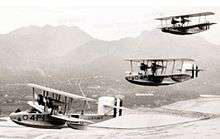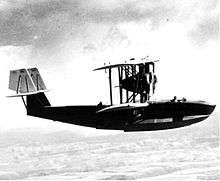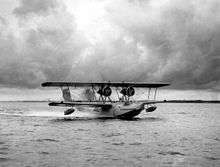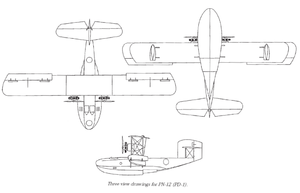Naval Aircraft Factory PN
The Naval Aircraft Factory PN was a series of open cockpit American flying boats of the 1920s and 1930s. A development of the Felixstowe F5L flying boat of the First World War, variants of the PN were built for the United States Navy by Douglas, Keystone Aircraft and Martin.
| PN | |
|---|---|
 | |
| Naval Aircraft Factory PN-12 | |
| Role | Patrol Flying Boat |
| Manufacturer | Naval Aircraft Factory |
| Retired | 1938 (PK-1) |
| Primary user | United States Navy |
| Developed from | Felixstowe F5L |
| Variants | Hall PH |
Development and design
The chief long-range patrol flying boats of the United States Navy at the end of World War I were the Curtiss H.16 and the similar Felixstowe F5L.
The F5L was a license-built version of the British Felixstowe F.5 using the American Liberty engine. The series of Felixstowe flying boats, developed by the Seaplane Experimental Station, had started with improving the hull of the Curtiss H12. The Naval Aircraft Factory, which had built F.5Ls during World War I, continued development of the design, which was redesignated PN-5 in 1922 (although in practice continued to be known as F.5Ls), with the final two being built to an improved design, the F-6L (later designated PN-6).[1] In 1925, the Naval Aircraft Factory produced a version with new wings with an airfoil section of greater maximum lift coefficient. It was powered by experimental 525 hp (391 kW) Wright T-2 piston engines, and was designated PN-7.

Although the new wing proved successful, the engines were unreliable, and the wooden hull inherited from the F.5 required much maintenance, so two aircraft with metal hull construction, powered by 475 hp (354 kW) Packard engines, were built as the PN-8. Further, similar aircraft were built as the PN-9 and PN-10, but the water-cooled V-12 Packard engines were disappointing and radial engines were substituted to produce the PN-12. This combination of the revised wings introduced by the PN-7, with a metal hull and radial engines met the requirements of the Navy and therefore the PN-12 formed the basis of more extensive production to re-equip its patrol squadrons. As the production capacity of the Naval Aircraft Factory was limited, production was contracted out to several aircraft companies, with versions being built by Douglas (PD-1), Keystone Aircraft (PK-1) and Martin (PM-1 and PM-2).[4]
The PN-12 was a twin-engined biplane with fabric-covered metal-framed wings, its engines being mounted in nacelles between the wings. While the hull was constructed of metal, it was otherwise similar to that of the F.5L, with the large sponsons that were a feature of both that aircraft and the Felixstowe and Curtiss flying boats to which it could trace its heritage. It had a standard crew of five, but was capable of carrying a relief crew for long patrols.[4]
The PN-11 featured a revised hull which eliminated the sponsons. It also used twin vertical tails. Four of this variant were built. They were the basis of the Hall PH flying boats, some of which remained in service until World War II.
Operational history
The early prototypes of PN sea planes were used in a series of long-distance flights. During the afternoon of 31 August 1925, an attempt was made to fly a pair of PN-9 planes non-stop from San Francisco to Hawaii, a distance of nearly 2,400 miles (3,864 km) — a trip anticipated to take 26 hours to complete.[5] The first plane to start was forced to land 300 miles outside of San Francisco due to a failure of oil pressure, with the crew rescued by the destroyer USS William Jones and the aircraft towed back to port.[5]
The second PN-9 to depart, captained by U.S. Navy Commander John Rodgers, flew 1,841 miles before running out of fuel when anticipated tailwinds that would have slowed gasoline consumption did not materialize.[5] The plane was unable to make contact with the naval airplane tender USS Aroostook, a ship stationed along the PN-9's flight path and was forced to land at sea when both engines stopped functioning.[5] With power lost, the plane was unable to send or receive radio signals.[5] Although this was at the time a new distance record for seaplanes, the plane remained hundreds of miles short of the nearest landfall and the situation of the crew, with limited quantities of food and water, appeared dire.
Since seas were moderate, the decision was made to attempt to sail the plane to Hawaii.[5] The crew then rigged crude sails made from fabric torn from the aircraft's wings and sailed the aircraft a further 450 miles, finally being spotted on the ninth day about 15 miles off the southeast coast of the Hawaiian island of Kauai.[5] In the aftermath of the headline-grabbing rescue, Commander Rogers was promoted to the position of Assistant Chief of the Navy's Bureau of Aeronautics.[5] PN-9 No. 1, the same plane sailed to Hawaii, did not fare as well, later ditching in the Caribbean Sea during an attempted long distance flight to South America and subsequently sunk as a navigation hazard.[6]
The two PN-12s were also used to set various records, including range and speed over circuit records.
The various production derivatives of the PN-12 entered service with the US Navy from 30 April 1928, when VP-7D received its first Douglas PD-1, remaining in service until July 1938, when the last Keystone PK-1 was retired.[4]
Three Martin PM-1s were also supplied to the Brazilian Navy in 1930, and used in bombing raids during the 1932 revolution.[7]
Variants




- PN-5
- Redesignated Felixstowe F5L
- PN-6
- Redesignated F-6L. Last two Naval Aircraft Factory F5Ls, modified with revised tail surfaces.
- PN-7
- Modified version with new wings with high-lift thick aerofoil section and reduced wingspan (72 ft 10 in compared with 103 ft 9 in). Powered by two 525 hp (391 kW) Wright T-2 engines. Two built.
- PN-8
- PN-7 with metal hull. Powered by two 475 hp (354 kW) Packard 1A-2500 V-12 engines. Two built.
- PN-9
- Converted from PN-8 with redesigned engine nacelles. One converted.
- PN-10
- Similar to PN-8. Powered by two 500 hp (370 kW) Packard 1A-2500. Two built.
- PN-11
- New hull eliminating sponsons, fitted with twin vertical tail surfaces. Four built, one with two Pratt & Whitney R-1690 Hornet engines, and remaining three powered by two Wright R-1750D Cyclone.
- XP4N-1
- Improved PN-11; three aircraft ordered, originally designated XP2N but redesignated XP4N-1 before delivery. Last two aircraft completed as XP4N-2s.[8]
- XP4N-2
- Improved XP4N-1 with additional fuel capacity.[8]
- PN-12
- Development of PN-10 powered by radial engines. Two built. One powered by two Pratt & Whitney Hornet engines, with the other powered by two Wright R-1750 Cyclone engines.
- Douglas PD-1
- Developed production version of PN-12. Two 575 hp (429 kW) Wright R-1750 Cyclone engines. 25 built by Douglas.
- Keystone PK-1
- Production version of PN-12. Twin tails. Two 575 hp (429 kW) Wright R-1820 Cyclone engines. 18 built by Keystone.
- Martin PM-1
- Production derivative of PN-12. Two 525 hp (391 kW) Wright R-1750 Cyclone engines. 27 built for US Navy by Martin.
- Martin PM-1B
- Export version of PM-1 for Brazil. Three built.
- Martin PM-2
- Improved derivative of PM-1 with more powerful Wright R-1820 Cyclone engines and twin tails. 25 built.
Specifications (PN-12)

Data from United States Navy Aircraft since 1911
General characteristics
- Crew: Five
- Length: 49 ft 2 in (14.99 m)
- Wingspan: 72 ft 10 in (22.21 m)
- Height: 16 ft 9 in (5.11 m)
- Wing area: 1,217 ft2 (113.1 m2)
- Airfoil: USA 27
- Empty weight: 7,699 lb (3,500 kg)
- Loaded weight: 14,122 lb (6,419 kg)
- Powerplant: 2 × Wright R-1750 D Cyclone 9-cylinder single row radial engine, 525 hp (392 kW) each
Performance
- Maximum speed: 99 knots (114 mph, 184 km/h) at sea level
- Range: 1,139 nm (1,310 mi, 2,109 km)
- Service ceiling: 10,900 ft (3,300 m)
- Wing loading: 11.6 lb/ft2 (56.8 kg/m2)
- Power/mass: 0.074 hp/lb (0.12 kW/kg)
- Climb to 5,000 ft (1,520 m): 16 min
Armament
- Single .30 in (7.62 mm) calibre machine guns in bow and amidships cockpits
- Four 230 lb (105 kg) bombs underwing
See also
Related development
Aircraft of comparable role, configuration and era
Related lists
References
- Elliott, John M. (2000). "Dictionary of American Naval Aircraft Squadrons — Volume 2 Appendix 1 – Aircraft Data-Technical Information and Drawings" (pdf). Naval Historical Center. p. 639. Retrieved 2007-10-01.
- Elliott, John M. (2000). "Dictionary of American Naval Aviation Squadrons — Volume 2 Appendix 1-Aircraft Data-Technical Information and Drawings" (pdf). Naval Historical Center. Retrieved 2007-10-01.
- "Flight to Hawaiian Islands," in James Langland (ed.), The Chicago Daily News Almanac and Year-Book for 1926. Chicago: Chicago Daily News Company, 1925; pg. 629.
- "American airplanes: Naval Aircraft Factory". Aerofiles. Retrieved 2007-10-03.
- "PM Series" (PDF). Maryland Aviation Museum. Archived from the original (pdf) on 2008-07-24. Retrieved 2007-10-03.
- Johnson 2011, p.147.
- Johnson, E.R. (2009). American Flying Boats and Amphibious Aircraft: An Illustrated History (illustrated ed.). McFarland. pp. 186–187. ISBN 0786439742.
- Johnson, E. R. (2011). United States Naval Aviation, 1919–1941: Aircraft, Airships and Ships Between the Wars. Jefferson, NC: McFarland and Company. ISBN 978-0-7864-4550-9.
- Swanborough, Gordon; Bowers, Peter M. (1976). United States Navy Aircraft since 1911 (Second ed.). London: Putnam. ISBN 0-370-10054-9.
External links
| Wikimedia Commons has media related to Naval Aircraft Factory PN. |